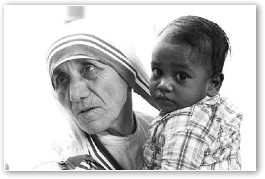Mother Teresa was faithfully orthodox and radically charitable
- FATHER RAYMOND J. DE SOUZA
Pope Francis declared Mother Teresa of Calcutta a saint on Sunday.

A canonization is usually an occasion for the Catholic Church to highlight a noble life that's worthy of admiration and emulation. In this case, the Church was confirming a judgment already made by the world — that the sister from the slums was indeed a saint.
In 1985, six years after she received the Nobel Peace Prize — which was still a prestigious award in 1979 — Mother Teresa was awarded the U.S. Presidential Medal of Freedom. The citation called her the "saint of the gutters." There have been others who have risen from the gutters to receive such awards, but she was the only one who went back to the gutters to live.
Mother Teresa was as astonishingly improbable figure for the 20th century. The world's most famous religious person was born in Albania, a country that communist depredations would render the most godless on Earth. She would become a universally known Christian disciple, despite dwelling in the obscure slums of Calcutta, where Christians are rare.
The rich and the mighty would vie to be in the presence of one who chose to live with the wretched, the sick, the diseased and the dying. A wizened and stooped woman who wore the same poor habit every day became a celebrity and possessed a greater beauty than the plastic princesses and superficial socialites who she taught to measure their philanthropy according to the standard of "giving until it hurts."
As Catholic cultures in one country after another were abandoning their faith, she founded the fastest-growing religious order in the world, offering nothing but the love of Christ and the opportunity to serve Him in the "distressing disguise of the poor." In a century in which the most "advanced" countries on both sides of the Atlantic embraced eugenics for "inferior races" and the disabled, she stood foursquare at the side of the vulnerable and the voiceless. Hugh Hefner seduced a generation with pornographic scantily clad in the "playboy philosophy;" Mother Teresa rejected the sexual revolution and all its pomps and works, in favour of the theological virtues of faith, hope and sacrificial love.
And if religion is to be a cultural force for good in the 21st century, St. Teresa of Calcutta will be the model. The great division in 20th-century religion between doctrine and good works, between preaching the truth and doing charitable service, downplaying the former while emphasizing the latter, was overcome by Mother Teresa. She was faithfully orthodox and radically charitable. Long before the world discovered her in Malcolm Muggeridge's 1969 documentary, Something Beautiful for God, she was a vivid witness that truth without love can be cold and love without truth becomes shallow sentimentality. In the 21st century, Christian witness will follow in the steps of St, Teresa, or it will disappear entirely.
Mother Teresa died 19 years ago, on Sept. 5, 1997, a few days after Diana, Princess of Wales, and Dodi Fayed were killed in the automobile crash in Paris. The stiff upper lip of the British collapsed that week into a blubbering mess, evidence that an entire culture can temporarily lose its mind. As they heaped laudations upon the most glamorous woman alive for permitting herself to be photographed with AIDS patients, Mother Teresa’s death in Calcutta reminded the world of those sisters who welcomed AIDS sufferers into their homes, tended their wounds and emptied their bedpans when no photographers were around.
Diana's brother, a synthesis of hereditary privilege and commercial vulgarity, claimed the body of his sister for the family estate, hoping to cash in on star-struck tourists seeking to mourn the loss of the people's princess, comforted by the strains of Elton John wailing in Westminster Abbey. Diana lies largely forgotten now, her memory fading like yesterday’s hit song.
In Calcutta, daily they come, the poor of the city and pilgrims from every corner of the world, Catholic sisters alongside Hindus, Muslims, Buddhists and others, to pray at the tomb of Mother Teresa. Pope Francis, at the beginning of his pontificate, said he wanted a Church to stand in solidarity with the suffering. He “dreamed of a poor Church for the poor.” He was dreaming of the life Mother Teresa lived. On Sunday, he proposed that life anew to the Church and to the world.
 This is Meaghen Gonzalez, Editor of CERC. I hope you appreciated this piece. We curate these articles especially for believers like you.
This is Meaghen Gonzalez, Editor of CERC. I hope you appreciated this piece. We curate these articles especially for believers like you.
Please show your appreciation by making a $3 donation. CERC is entirely reader supported.

Acknowledgement
 Father Raymond J. de Souza, "Mother Teresa was faithfully orthodox and radically charitable." National Post, (Canada) September 6, 2016.
Father Raymond J. de Souza, "Mother Teresa was faithfully orthodox and radically charitable." National Post, (Canada) September 6, 2016.
Reprinted with permission of the National Post and Fr. de Souza.
The Author
Father Raymond J. de Souza is the founding editor of Convivium magazine.
Copyright © 2016 National Post



